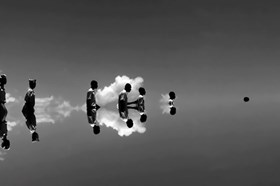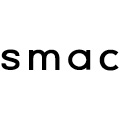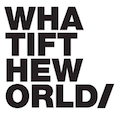artthrob artbio
Serge Alain Nitegeka
By Michael Smith
Serge Alain Nitegeka
Fragile Cargo Studio study VI,
2010.
paint on wood
Two panels, 170 x 246cm total.
In 2000 it was estimated that there were in the region of 20 million people all over the globe who had experience some manner of forced migration. Despite the prevalence of the forced migrant’s experience, the theme remains politically and culturally elusive.
Locally the economic hubs of Gauteng, eThekwini and Cape Town have become increasingly cosmopolitan since the democratic liberation of our country in the mid-1990s, as the allure of survival possibilities attracts large numbers of Africans from well outside our borders. Yet, despite their increasing numbers within our country, economic and socio-political migrants remain largely without representation, especially in culture.
It is possibly fitting that Serge Alain Nitegeka’s presence in the public eye has increased since around the time of the explosion of xenophobic violence in 2008. Since then this Burundi-born naturalised South African artist has been steadily carving a place for himself in the South African contemporary art scene. At that time Nitegeka, an undergraduate at Wits University’s School of Arts, was setting the terms of his production, and establishing his artistic vocabulary.
art events calendar
VIEW FULL CALENDARbuy art prints
edition of 25: R4,300.00
About Editions for ArtThrob
Outstanding prints by top South African artists. Your chance to purchase SA art at affordable prices.
FIND OUT MORE Editions for artthrobModus Operandi
Nitegeka’s initial work operated around the notion of inserting himself into the role of the forced migrant. A seminal body of work produced while he was still an undergraduate consisted of expressive, compelling large-scale self-portraits in charcoal on packaging crates. As with all his subsequent work, the approach was strongly autobiographical: he was forced to flee his native Burundi due to civil war in the early '90s. He has been living in Johannesburg since 2003.
Continuing his education in Johannesburg and becoming a legal resident as soon as he was able, he was nonetheless marked by this sense of dislocation, and of his status as a migrant, as human cargo. His evolving understanding of his situation came with a sense of the ubiquity of his experience, and although his initial works predominantly utilised his own face and body, they resonated with many in South Africa.
Since around 2009 he has been experimenting with more allusive imagery: neo-minimalist paintings from his ‘Fragile Cargo’ series saw the artist using silhouettes of himself amidst forests of structures, the looming black and grey scaffolds, ladders and sometimes amorphous volumes dwarfing and obscuring the figures.
Notes of flat, iconographic colour were inserted into these otherwise monochromatic works: lines of red paint, and panels of yellow wood grain emerge to marshal one’s eye around the compositions, in a manner suggestive of diagrammatic arrows and markings. There is also a sense that these works quietly upend some of the strategies employed by Piet Mondrian in his De Stijl works, where grids of black, white and grey are punctuated with sharp, primary colours. Yet, while Mondrian’s intentions were to postulate a new aesthetic and social purity, Nitegeka’s couldn’t be further away, imaging instead the labyrinth of obstacles and metaphorical structures that impede the progress of the forced migrant.
Most recently, Nitegeka has moved into pure installation, as if the structures from the ‘Fragile Cargo’ paintings needed to come to life in three dimensions. Works such as Tunnel shown on the group show ‘This is Our Time’ and '...and walk in my shoes.' shown at the 2011 Grahamstown National Arts Festival literally enter and disrupt the viewer’s space. The figures that had appeared in Nitegeka’s paintings are replaced in these installations by the viewer’s body: ‘I have removed the rendered figure from this work, but you, the viewer, become that body. I'm giving that role to whoever is in the space for that moment.’
Artist’s statement
‘My work investigates the concept of liminality in the frame of forced migration. I study the in-between state and space in which some marginal individuals such as asylum seekers and refugees find themselves. I am interested in the possibilities through which the human form can be stripped down and reduced into simple lines that articulate the relationship between movement and load.
This concept is explored through site-specific installations that depend on the viewers’ participation to be complete. The installations are realized through slight/total transformation of familiar and ordinary space/s so as to command the body to behave and move in a directed way, almost as if to perform a ritual. The idea, or rather the metaphor, is to get the viewers to experience what it may be like for refugees and asylum seekers to cross borders and boundaries, to be in unfamiliar space of different cultures, or to negotiate the mazes of social-political systems and foreign diets.’
What others have said
‘Nitegeka’s work focuses on the politics of forced migration. Through the use of drawing, installation, sculpture and performance the artist seeks to explore particular experiences of human travel. He uses the motif of second-hand crates to communicate multiple issues around carriers and those carried across borders.’
• Rat Western, ArtThrob, November 2010
'[Studio Study I is] one in a series of paintings titled “Fragile Cargo,” [...] exhibited at Michael Stevenson’s summer exhibition. This picture is described as a “meditation” on form, based on Nitegeka’s experience in Johannesburg. Nitegeka uses a limited color palette of black, white, grey natural wood grain and red highlights to offer abstracted, fragmented shapes. The flat application of paint delineates sharp contrasts, bold angular lines and geometric forms. Assembled, the visual elements describe a designed interior space (the “studio”) that envelops a figure that leans on furniture or scaffolding depicted by lines and squares. Painted in black, the form advances and recedes on a surface of grey and white. This interior scene is punctuated by moments of red spilled onto the wood grain, or long lines of fire red in the place of a corner, wall or horizon line...
The flat arrangement of geometric form seems to create a logical system, a system through which the depicted figure navigates by means of arrangement, colour and perspective and into which viewers are drawn. Squares, scaffolding and hardwood surfaces are distilled to simplistic forms, and are suggestive of modern architecture and graphic design. Simultaneously, Studio Study I invokes innovations in modern (and postmodern) painting through depictions of interior space, compositions that involve cropping and asymmetry, unexpected points of view, and fragmented pictorial space.’
• Raél Salley, Art South Africa, Autumn 2011
Currently
Nitegeka is currently finishing an MA in Fine Arts at Wits University. Also, meeting various exhibition commitments involves ‘serious studio time’.
Before that
Nitegeka’s installation ‘...and walk in my shoes.’ at the 2011 Grahamstown National Arts Festival was a great success. A compelling energising of the difficult rotunda space of the Gallery in the Round at the very bottom of the 1820 Settlers’ Monument, it utilised a maze of painted timber to intervene in the space, radically constricting the visitor’s movement within the space. The titular directive was literal and figurative: the artist intended for the viewer to move through the space in a manner that was unnaturally prescribed, awkward and potentially hazardous, to communicate the process forced migrants experience when the move to a new country necessitates a negotiation of new social, political and economic obstacles.
And before that
Nitegeka worked on a couple of projects in the past three or so years, but the most recent and outstanding project was the ‘…A 100 stools’ with the Goethe Institute. As Nitegeka says, ‘The project consists of 100 pine wood stools that were to be given to asylum seekers and refugees queuing outside the Department of Home Affairs at Crown Mines. The aim was to humanise the migrants’ experience and exchange with the Department. The first performance (handing out of stools) was obstructed by overnight security. The second performance is scheduled for mid-October 2011.’
Next up
Nitegeka says about his future career trajectory, ‘I see my work as a narrative that is writing itself, unfolding itself in good time. It is in process: from the finished work, to work in progress in the studio, to the work yet to be made – and, of course, the unknown destinations and avenues yet to be travelled. I look forward to all these aspects!’
Curriculum Vitae
SOLO EXHIBITIONS
2011
'...and walk in my shoes', Gallery in the Round, National Arts Festival, Grahamstown
2010
‘Fragile Cargo’, Michael Stevenson, Cape Town
2009
‘Cargo’, Wits School of Arts, University of the Witwatersrand, Johannesburg?Cargo, Side gallery, Michael Stevenson, Cape Town
2008
‘Human Cargo’, The Mezzanine, University of the Witwatersrand, Johannesburg
SELECTED GROUP EXHIBITIONS
2011
‘Process This’, Michaelis Galleries, University of Cape Town; ‘Geography of Somewhere’, Brodie/Stevenson, Johannesburg
2010
‘Gazart II’, Main Street Life, Johannesburg; ‘Dak'Art’, 9th Dakar Biennale, Senegal; ‘This is Our Time’, Michael Stevenson, Cape Town; ‘Time's Arrow’, Johannesburg Art Gallery, Johannesburg
2009
‘GROTESQUE: the elusive figure’, The Substation, University of the Witwatersrand, Johannesburg; ‘Self/Not-Self’, Brodie/Stevenson, Johannesburg; ‘Re: Faced’, The Substation, University of the Witwatersrand, Johannesburg
2008
‘Beyond the Line’, Goethe Institute, Johannesburg; ‘Martienssen Prize Exhibition’, Wits Gallery, University of the Witwatersrand, Johannesburg; Students' Exhibition’, Wits Gallery, University of the Witwatersrand, Johannesburg
AWARDS
2010
Tollman Award for Visual Arts, Fondation Jean-Paul Blachère prize; Postgraduate Merit Award, University of the Witwatersrand
2008
Robert Hodgins Prize, University of the Witwatersrand



















